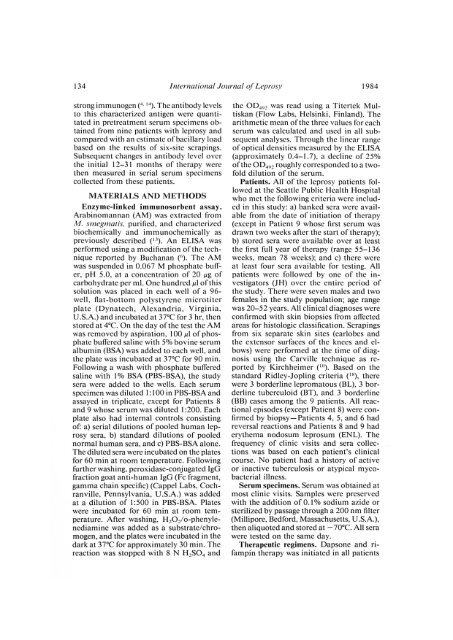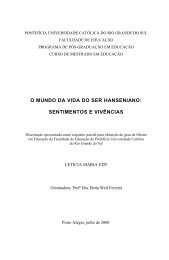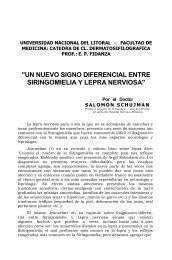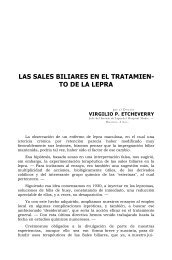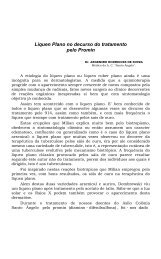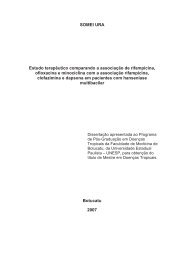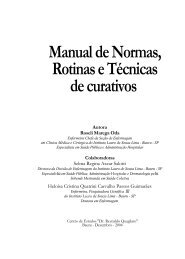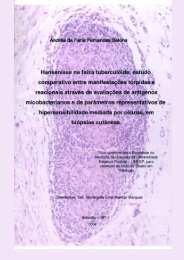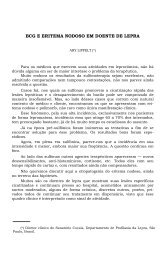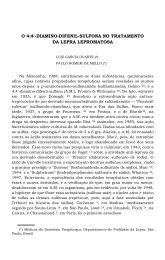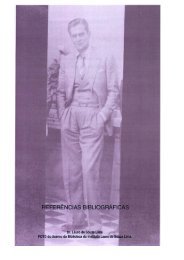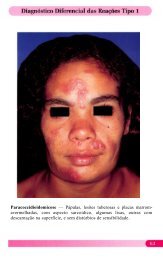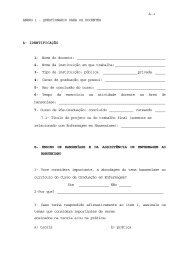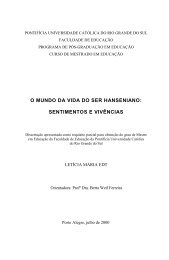INTERNATIONAL JOURNAL OF LEPROSY - Index of
INTERNATIONAL JOURNAL OF LEPROSY - Index of
INTERNATIONAL JOURNAL OF LEPROSY - Index of
Create successful ePaper yourself
Turn your PDF publications into a flip-book with our unique Google optimized e-Paper software.
134^ International Journal <strong>of</strong> Leprosy^ 1984<br />
strong immunogen ' 4). The antibody levels<br />
to this characterized antigen were quantitated<br />
in pretreatment serum specimens obtained<br />
from nine patients with leprosy and<br />
compared with an estimate <strong>of</strong> bacillary load<br />
based on the results <strong>of</strong> six-site scrapings.<br />
Subsequent changes in antibody level over<br />
the initial 12-31 months <strong>of</strong> therapy were<br />
then measured in serial serum specimens<br />
collected from these patients.<br />
MATERIALS AND METIIODS<br />
Enzyme-linked immunosorbent assay.<br />
Arabinomannan (AM) was extracted from<br />
Al. smegmatis, purified, and characterized<br />
biochemically and immunochemically as<br />
previously described ( 13). An ELISA was<br />
performed using a modification <strong>of</strong> the technique<br />
reported by Buchanan ( 6). The AM<br />
was suspended in 0.067 M phosphate buffer,<br />
pH 5.0, at a concentration <strong>of</strong> 20 pg <strong>of</strong><br />
carbohydrate per ml. One hundred pl <strong>of</strong> this<br />
solution was placed in each well <strong>of</strong> a 96well,<br />
flat-bottom polystyrene microtiter<br />
plate (Dynatech, Alexandria, Virginia,<br />
U.S.A.) and incubated at 37°C for 3 hr, then<br />
stored at 4°C. On the day <strong>of</strong> the test the AM<br />
was removed by aspiration, 100 pl <strong>of</strong> phosphate<br />
buffered saline with 5% bovine serum<br />
albumin (BSA) was added to each well, and<br />
the plate was incubated at 37°C for 90 min.<br />
Following a wash with phosphate buffered<br />
saline with 1% BSA (PBS-BSA), the study<br />
sera were added to the wells. Each serum<br />
specimen was diluted 1:100 in PBS-BSA and<br />
assayed in triplicate, except for Patients 8<br />
and 9 whose serum was diluted 1:200. Each<br />
plate also had internal controls consisting<br />
<strong>of</strong>: a) serial dilutions <strong>of</strong> pooled human leprosy<br />
sera, b) standard dilutions <strong>of</strong> pooled<br />
normal human sera, and c) PBS-BSA alone.<br />
The diluted sera were incubated on the plates<br />
for 60 min at room temperature. Following<br />
further washing, peroxidase-conjugated IgG<br />
fraction goat anti-human IgG (Fe fragment,<br />
gamma chain specific) (Cappel Labs, Cochranville,<br />
Pennsylvania, U.S.A.) was added<br />
at a dilution <strong>of</strong> 1:500 in PBS-BSA. Plates<br />
were incubated for 60 min at room temperature.<br />
After washing, H 20,/o-phenylenediamine<br />
was added as a substrate/chromogen,<br />
and the plates were incubated in the<br />
dark at 37°C for approximately 30 min. The<br />
reaction was stopped with 8 N H,S0, and<br />
the 013,,,, was read using a Titertek Multiskan<br />
(Flow Labs, Helsinki, Finland). The<br />
arithmetic mean <strong>of</strong> the three values for each<br />
serum was calculated and used in all subsequent<br />
analyses. Through the linear range<br />
<strong>of</strong> optical densities measured by the ELISA<br />
(approximately 0.4-1.7), a decline <strong>of</strong> 25%<br />
<strong>of</strong> the 01) 4 .), roughly corresponded to a tw<strong>of</strong>old<br />
dilution <strong>of</strong> the scrum.<br />
Patients. All <strong>of</strong> the leprosy patients followed<br />
at the Seattle Public Health Hospital<br />
who met the following criteria were included<br />
in this study: a) banked sera were available<br />
from the date <strong>of</strong> initiation <strong>of</strong> therapy<br />
(except in Patient 9 whose first scrum was<br />
drawn two weeks after the start <strong>of</strong> therapy);<br />
b) stored sera were available over at least<br />
the first full year <strong>of</strong> therapy (range 55-136<br />
weeks, mean 78 weeks); and c) there were<br />
at least four sera available for testing. All<br />
patients were followed by one <strong>of</strong> the investigators<br />
(JH) over the entire period <strong>of</strong><br />
the study. There were seven males and two<br />
females in the study population; age range<br />
was 20-52 years. All clinical diagnoses were<br />
confirmed with skin biopsies from affected<br />
areas for histologic classification. Scrapings<br />
from six separate skin sites (earlobes and<br />
the extensor surfaces <strong>of</strong> the knees and elbows)<br />
were performed at the time <strong>of</strong> diagnosis<br />
using the Carville technique as reported<br />
by Kirchheimer ('"). Based on the<br />
standard Ridley-Jopling criteria ('s), there<br />
were 3 borderline lepromatous (BL), 3 borderline<br />
tuberculoid (BT), and 3 borderline<br />
(BB) cases among the 9 patients. All reactional<br />
episodes (except Patient 8) were confirmed<br />
by biopsy—Patients 4,5, and 6 had<br />
reversal reactions and Patients 8 and 9 had<br />
erythema nodosum leprosum (ENL). The<br />
frequency <strong>of</strong> clinic visits and sera collections<br />
was based on each patient's clinical<br />
course. No patient had a history <strong>of</strong> active<br />
or inactive tuberculosis or atypical mycobacterial<br />
illness.<br />
Serum specimens. Serum was obtained at<br />
most clinic visits. Samples were preserved<br />
with the addition <strong>of</strong> 0.1% sodium azide or<br />
sterilized by passage through a 200 nm filter<br />
(Millipore, Bedford, Massachusetts, U.S.A.),<br />
then aliquoted and stored at —70°C. All sera<br />
were tested on the same day.<br />
Therapeutic regimens. Dapsone and rifampin<br />
therapy was initiated in all patients


